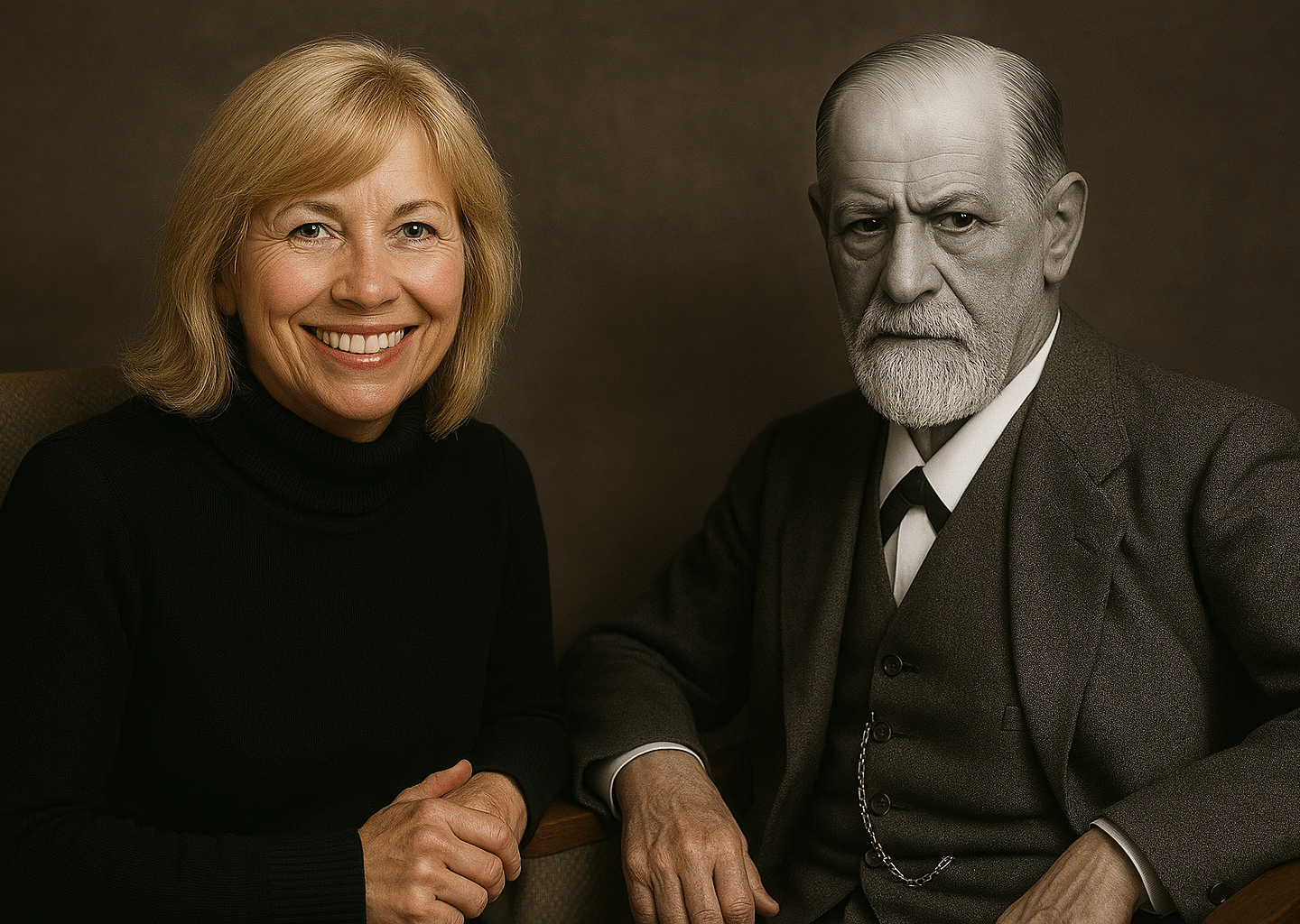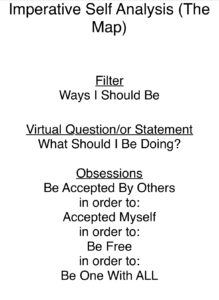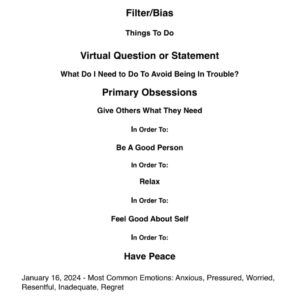Almost every emotional problem is driven by an unconscious childhood command — Do, Be, or Get — that shapes your perception, reactions, identity, and behaviors until it is brought into awareness and rewritten.
That’s the Imperative Self.
And once you see it, you can’t unsee it.
This 6-minute Google video introduces one of the most powerful tools for personal transformation ever discovered in psychology. It’s a concise, eloquent look at how we can begin to rewrite the emotional patterns that shape our lives:
Over the past 40+ years, I’ve explored and applied many therapeutic models—both personally and professionally. Many of them have proven to be gentle yet remarkably powerful in transforming emotions and behaviors. Still, none offered a way to represent the whole person. Much of my earlier work prior to 1989, therefore, was fragmented—addressing isolated issues rather than the full structure of an individual’s experience.
In 1988, a model emerged: the Imperative Self—finally providing a framework for understanding and working with the total personality.
Ever feel like you’re doing all the right things—therapy, journaling, self-help—but still stuck in emotional loops you can’t name?
You’re not broken. You’re simply running on an emotional autopilot that’s been steering your life since childhood.
Until you uncover it, you’ll keep reacting the same way to different situations.
That’s where Imperative Self Analysis (ISA) comes in. It’s about finding the needle in the haystack to make a positive change to your emotional life.
What Is Imperative Self Analysis (ISA)?
ISA is a streamlined therapeutic model that identifies the 5–7 emotions that quietly dominate your daily life and reveals the hidden command that drives them.
It’s not a mindset trick or years of talk therapy.
In just a few focused hours, ISA helps you map your unconscious emotional code — the patterns that shape your reactions, relationships, and sense of self-worth.
If Freud introduced the unconscious, ISA names the commands that run it.
When your Imperative Self is aligned, life no longer feels like a struggle between doing and being. You don’t wake up asking, “Is this all there is?” Your emotions are calm, satisfied, and at peace — guided by a deeper inner harmony rather than restless searching.
Your Emotional Palette
We each live with a personal emotional palette — a small set of feelings that repeat day after day.
They aren’t random; they form your emotional fingerprint.
Start by downloading and completing the Emotional States Menu (PDF):
👉: Please fill out the attached Emotional Checklist below by selecting the 5-7 most common emotions you experienced during the past seven days.Be sure to evaluate a “typical” time period. That is, not during your vacation, after you have just started a new job, or just after a recent divorce or marriage. While emotions experienced during these situations are certainly revealing, we (you and I) want to know about those emotions that constitute the emotional themes of your life.
Once you have made an initial list (by circling some of those emotions listed on the “menu” or writing in your own), check it for any missing emotions. For instance, what do you feel while absorbed in your work? Often we are engaged in activities that take up a substantial portion of our day, yet which also typically leave us unaware of any emotions. However, if you attend closely, you will discover that there is an emotion going on. Perhaps anticipation of the results our completed work will bring, or perhaps a feeling of being pressured and hassled about the scarcity of time left to complete the task.
Remember to select emotions rather than behaviors. Please email me these 5-7 emotions you selected prior to our session.
Some clients like to print the list and make 6-7 copies. Every night they go over their day and circle the experienced emotions. At the end of the week, it is easier to notice their 5-7 most common emotions.
That awareness opens the door to deeper change.
Where ISA Came From
Developed in 1988 by therapist Leslie Cameron Bandler (now Cameron-Lebeau), ISA was born from two simple questions:
- Why do people react so differently to the same event?
- Why do some clients keep reliving the same emotion without resolution?
The breakthrough came with the idea of the Virtual Question — a silent belief or command formed in childhood that drives adult emotions and behavior.
What You’ll Discover
ISA helps you identify:
- Your core emotions (your 5–7 recurring feelings)
- Your Filter (the lens you see life through)
- Your Virtual Question (the silent command running your choices) Examples: Self_Limiting_Virtual_Questions
- Your Primary Obsessions (themes that pull your focus)
Most clients experience a major emotional shift within 2–3 hours — not years. Your IS Map is like your finger prints!
Note: I have had mixed results with clients on antipsychotic or psychotherapeutic medications, such as benzodiazepines, SSRIs, or stimulants like Adderall. Additionally, some individuals may not accurately report their true emotions.
How a Session Works
- You’ll be guided, not analyzed.
- You can say “pass” to any question.
- You’ll leave with a 40-word ISA Map summarizing your emotional program.
Breakthroughs often happen fast — and quietly.
Many clients describe the moment as: “It all suddenly made sense.”
Gentle and Non-Retraumatizing
Formed before the age of eight (8) during an emotionally charged moment/s, our Primary Obsessions become the focal point of our lives. They mirror the desires typical of a child aged 5-7 years. They are about doing, being, or getting. By reflecting on the Emotional Menus PDF and the contexts in which these emotions arise, you may begin to recognize your obsessions.
ISA doesn’t require reliving painful memories.
Instead, we start from your emotional strengths before the trauma and build from there.
For examples, see:
Cost & Guarantee
- Initial Session: $600 (2–3 hours)
- Follow-Up: $150/hour
- Sliding Scale: Available upon request
Guarantee:
To prove this is a real guarantee, you don’t have to pay me until those 5 to 7 emotions in your original emotional palette have faded into memory—no longer driving your day, just part of your story.
Real Client Transformations
Bill, 65:
“When I look through my old emotion list, I can’t find those feelings anymore. It’s as if I’ve been born again.”
Robin, 32:
Before ISA: Anxiety • Fear • Frustration
After ISA: Purposeful • Hopeful • Connected
“It’s crazy to see the difference. I’m so happy I no longer feel those things.”
Bobbie, 63:
Before: Anger • Anxiety • Frustration. Overwhelmed• Judgmental
After 3 sessions 29 months later: Confident• Gratitude • Awe • Patience • Loving • Free
“I was surprised they’re all so positive—and yet, it’s so.”
Linda, 55:
A year later (3 sessions) text: Here’s the latest selection: patient, satisfied, grateful, accepting, worthwhile 😃
Take the First Step
- Download the Emotional States Menu
- Track your emotions for a week
- Contact me for a free Zoom consultation
📧 Email: Clint77090@gmail.com
(Please note: there is currently a waitlist.)
Final Thought
No one should have to have an Imperative Self.
We were meant to live by choice, not compulsion.
ISA helps you make that shift — quickly, safely, and permanently.
What You Might Be Thinking – If ISA is the best thing since sliced bread, why isn’t it a leading psychotherapy model? I believe there are five reasons for this:
- The ISA training was costly and required a significant time commitment, spanning over 24 days across several 6 weekends, with additional travel for some participants.
- The interventions to change the IS map were inadequate until the mid 1990s ( Clean Language) and required even more mostly trainings.
- Marketing a therapy model that promises significant changes in personality traits within a few sessions is challenging. The prevailing belief is that therapy should be a lengthy process. Leslie’s innovative approach was ahead of its time.
- Therapists often have established practices and may be reluctant to step outside their comfort zones to learn new methodologies.
- Successful ISA therapy often leads to the resolution of clients’ issues in a few sessions, resulting in a shorter duration of therapy and, consequently, a shorter revenue stream.
Why I Think ISA Should Matter to Therapists & Clients (and Might mark a Real Breakthrough)
Because ISA offers a framework that:
- Honors uniqueness, avoiding one-size-fits-all.
- Gets at the root causes — not just coping with symptoms, but rewriting internal programming.
- Bridges theory and practice: gives a map for where to apply other change tools (memory reconsolidation, NLP swish, Clean Language, etc.).
- Enables a more efficient and faster route to deep transformation (vs. years of symptomatic therapy).
- Respects the human system as complex, dynamic, and structured — not just a bag of “emotions” to manage, but an organized, patterned self to understand and evolve.
Our life’s purpose is to amass as many positive experiences as possible within our allotted time. The contentment we find in life is often a reflection of how well we navigate our emotional landscapes. By understanding and updating our Imperative Self Map, we can ensure that the negative emotions from our emotional palette become mere memories, allowing us to embrace a more fulfilling existence. Clint Matheny



